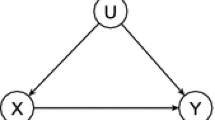Abstract
In order to introduce the basic notions used in our analysis, let us consider the structural form of our econometric model given by the set of n structural equations h(y,z) = 0, where y,(y∈Rn) and z,(z∈Rm) are the endogenous and exogenous variables respectively. To be regular, such a model has to verify the existence of a complete matching between the set of relations and the set of endogenous variables. This means that it has to be possible to assign a different left-hand variable to each equation, which enables us to write the model as a set of n explicit functions yi = gi(y;z). Then, if the model is written in this form, a non-zero derivative ∂gi/∂yjindicates the existence of a causal link going from variable yj to variable yi. The set of all these links defines what is called the causal structure of the model. The present study is based exclusively on information of this type.
Access this chapter
Tax calculation will be finalised at checkout
Purchases are for personal use only
Preview
Unable to display preview. Download preview PDF.
Similar content being viewed by others
References
Garbely, M. (1982), ‘Bases de causalité dans les modèles économiques interdépendants’, Cahiers du département d’économétrie, Université de Genève.
Giessen, van der, A.A. (1970),’ solving Non-linear Systems by Computer: a New Method’, Statistica Neerlandica, Vol. 24, No 1.
Gilli, M. and E. Rossier (1981), ‘Understanding Complex Systems’, Automatica, Vol. 17, pp. 647–652.
Gilli, M, (1982), ‘TROLL PROGRAM CAUSOR, A Program fo the Analysis of Recursive and Interdependent Causal Structures’, Technical Report No 37, Massachusetts Institute of Technology, Boston.
Guardabassi, G. (1971), ‘A Note on Minimal Essential Sets’, IEEE Trans Circuit Theory, CT-18, pp.557–562.
Held, M. and R. Karp (1969), ‘The Travelling Salesman Problem and Minimum Spanning Trees’, Operations Research, Vol. 18, No 6, pp. 1138–1162.
Tarjan, R. (1972), ‘Depth-first Search and Linear Graph Algorithms’, SIAM, J. Comput, Vol. 1, No 2, pp. 146–160.
Author information
Authors and Affiliations
Editor information
Rights and permissions
Copyright information
© 1984 Martinus Nijhoff Publishers, The Hague
About this chapter
Cite this chapter
Garbely, M., Gilli, M. (1984). Two Approaches in Reading Model Interdependencies. In: Ancot, J.P. (eds) Analysing the Structure of Econometric Models. Advanced Studies in Theoretical and Applied Econometrics, vol 2. Springer, Dordrecht. https://doi.org/10.1007/978-94-009-6098-5_2
Download citation
DOI: https://doi.org/10.1007/978-94-009-6098-5_2
Publisher Name: Springer, Dordrecht
Print ISBN: 978-94-009-6100-5
Online ISBN: 978-94-009-6098-5
eBook Packages: Springer Book Archive




